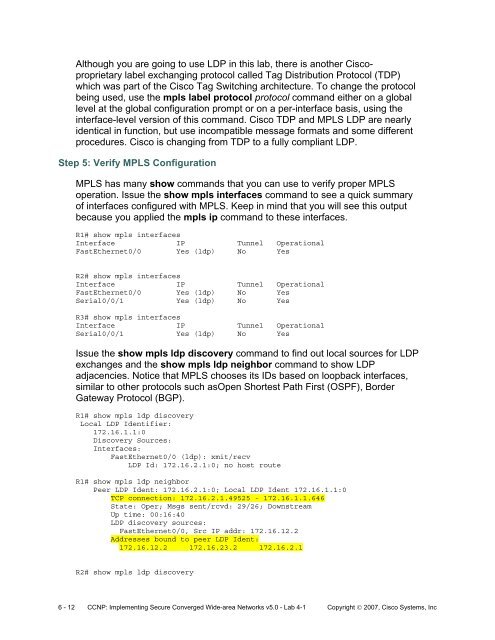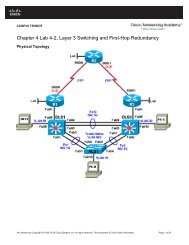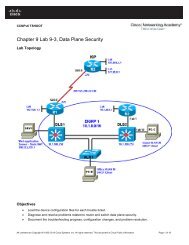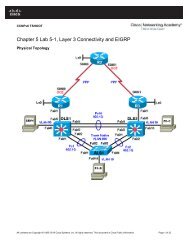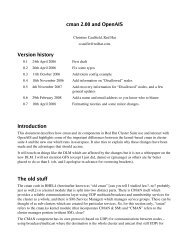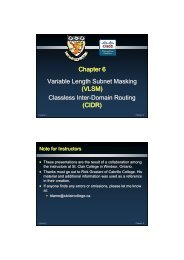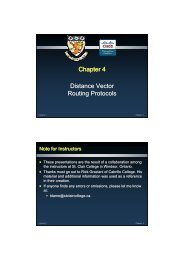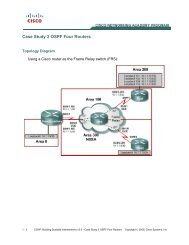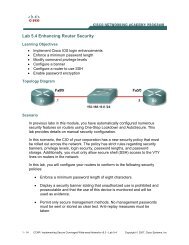Lab 4.1 Configuring Frame Mode MPLS
Lab 4.1 Configuring Frame Mode MPLS
Lab 4.1 Configuring Frame Mode MPLS
- No tags were found...
You also want an ePaper? Increase the reach of your titles
YUMPU automatically turns print PDFs into web optimized ePapers that Google loves.
Although you are going to use LDP in this lab, there is another Ciscoproprietary<br />
label exchanging protocol called Tag Distribution Protocol (TDP)<br />
which was part of the Cisco Tag Switching architecture. To change the protocol<br />
being used, use the mpls label protocol protocol command either on a global<br />
level at the global configuration prompt or on a per-interface basis, using the<br />
interface-level version of this command. Cisco TDP and <strong>MPLS</strong> LDP are nearly<br />
identical in function, but use incompatible message formats and some different<br />
procedures. Cisco is changing from TDP to a fully compliant LDP.<br />
Step 5: Verify <strong>MPLS</strong> Configuration<br />
<strong>MPLS</strong> has many show commands that you can use to verify proper <strong>MPLS</strong><br />
operation. Issue the show mpls interfaces command to see a quick summary<br />
of interfaces configured with <strong>MPLS</strong>. Keep in mind that you will see this output<br />
because you applied the mpls ip command to these interfaces.<br />
R1# show mpls interfaces<br />
Interface IP Tunnel Operational<br />
FastEthernet0/0 Yes (ldp) No Yes<br />
R2# show mpls interfaces<br />
Interface IP Tunnel Operational<br />
FastEthernet0/0 Yes (ldp) No Yes<br />
Serial0/0/1 Yes (ldp) No Yes<br />
R3# show mpls interfaces<br />
Interface IP Tunnel Operational<br />
Serial0/0/1 Yes (ldp) No Yes<br />
Issue the show mpls ldp discovery command to find out local sources for LDP<br />
exchanges and the show mpls ldp neighbor command to show LDP<br />
adjacencies. Notice that <strong>MPLS</strong> chooses its IDs based on loopback interfaces,<br />
similar to other protocols such asOpen Shortest Path First (OSPF), Border<br />
Gateway Protocol (BGP).<br />
R1# show mpls ldp discovery<br />
Local LDP Identifier:<br />
172.16.1.1:0<br />
Discovery Sources:<br />
Interfaces:<br />
FastEthernet0/0 (ldp): xmit/recv<br />
LDP Id: 172.16.2.1:0; no host route<br />
R1# show mpls ldp neighbor<br />
Peer LDP Ident: 172.16.2.1:0; Local LDP Ident 172.16.1.1:0<br />
TCP connection: 172.16.2.1.49525 - 172.16.1.1.646<br />
State: Oper; Msgs sent/rcvd: 29/26; Downstream<br />
Up time: 00:16:40<br />
LDP discovery sources:<br />
FastEthernet0/0, Src IP addr: 172.16.12.2<br />
Addresses bound to peer LDP Ident:<br />
172.16.12.2 172.16.23.2 172.16.2.1<br />
R2# show mpls ldp discovery<br />
6 - 12 CCNP: Implementing Secure Converged Wide-area Networks v5.0 - <strong>Lab</strong> 4-1 Copyright © 2007, Cisco Systems, Inc


